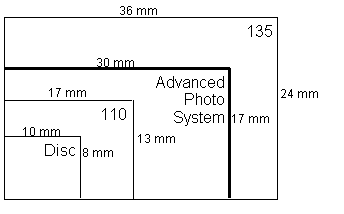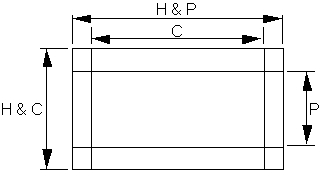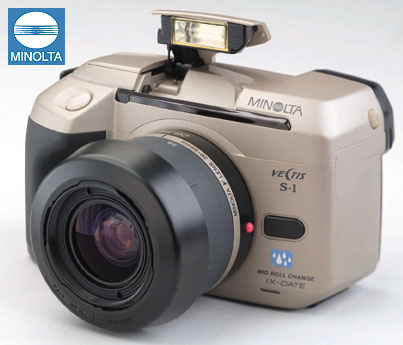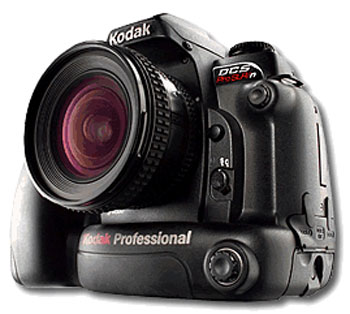The Digital Sensor: A Guide to Understanding Digital Cameras
by Wesley Fink on April 21, 2008 1:00 AM EST- Posted in
- Digital Camera
Why All these Different Sensor Sizes?
35mm first appeared on the scene in the 1930s and the film format simply took 35mm motion picture film and spooled it into a light-tight canister. By the 1960s, with point-and-shoot and developments in SLR technology, 35mm had become king of the film formats. Even as film manufacturers tried to introduce other film formats, 35mm continued to grow and prosper.
The SLR evolved in 35mm space and the world appeared orderly on the surface, but the only real constant was the size of the film. It was 35mm, but SLR manufacturers each championed their own lens mount and their exclusive lens line for their SLR film cameras. The primary advantage of the SLR was the ability to look through a wide variety of interchangeable lenses, and to accurately focus, meter, and later auto-focus through the viewing lens. As in today's digital SLR market, each manufacturer had their own lens mount, and lenses developed for one mount would not fit and work on others, i.e. a Nikon lens would not fit or work on a Canon camera.
APS (Advanced Photo System)
With the very early developments in digital photography, Kodak, Fuji, and others saw the handwriting on the wall for film photography. One of the ongoing complaints about 35mm film, however, has been that the 2:3 image format required image loss in almost every standard print size. Neither 8x10 nor 5x7 is a 2:3 ratio and both required cropping of the 35mm negative.

In 1996 a new APS (Advanced Photo System) initiative by Kodak, Fujifilm, Minolta, Nikon, Canon, and others was introduced to save film by standardizing on new ratios and adding new "computer-like" data storage capabilities in the taking and processing of film images. APS included a new film size - 30.2mm x 16.7mm - that could be printed full-frame (H or HDTV format), or use standard crops of 25.1mm x 16.7mm (C or Classic 2:3 format) or 9.5mm x 30.2mm (P or Panorama). Actually, the image size that was always shot was the 30.2mm x 16.7mm, and the other sizes were just standard crops.

The industry was confident they could sell APS, which in the most common C view was only about 55% of the already small 35mm size. Some manufacturers like Minolta developed new APS lens lines with smaller cameras and lenses, and Canon and Nikon developed APS camera bodies that could mount their regular lenses - and a few custom APS lenses.

In the end, APS failed in the film market. Industry pundits generally say APS failed because the negative was just too small, but it is more likely that it failed because it was just too late. Digital was on the near horizon, and many photographers did embrace smaller digital sensors while they rejected the smaller APS film format.
APS film is not that important in our discussion of digital photography, but the APS standard is important because it was also a standard for digital development. At the time of the APS initiatives, it seemed reasonable to aim for development of digital sensors for that same APS format, so lenses for both systems were interchangeable.
Most in the industry aimed for the APS C size sensor, which would be about 16.7mm x 25.1mm - the same ratio (2:3) as the classic 35mm format. Most manufacturers, burned by bad decisions in the APS film debacle, decided to keep their existing 35mm mounts, so their existing 35mm lenses could be used. They hedged their bets. This pleased current 35mm system owners, and camera makers could see if the new digital SLRs took hold. Once they were satisfied there was a market for digital SLR cameras, they could develop new lenses with a smaller image circle.

Canon and Nikon worked with Kodak in the early digital years to use their best film bodies with the current state-of-the-art Kodak sensors. These early DSLR cameras were incredibly expensive with massive power requirements and pro only. This development line culminated in the full-frame Kodak DCS Pro SLR/n and SLR/c. Those two cameras were the end of Kodak digital SLR cameras, although the company is still very active in the development and manufacture of digital imaging sensors and compact digital cameras.
Camera manufacturers introduced digital SLR products that revolved around the strength of their SLR business, the sensor capabilities they brought to manufacturing, and the relationships they had with other sensor manufacturers. Most of today's consumer DSLR cameras are based on sensors approximately APS C size, but they vary from the Olympus 4/3 sensor at 225mm² to the full-frame 35mm size with an area of 864mm².
Discussion of sensor size always tends to generate passionate discussion of the advantages of one manufacturer's sensor format over others, but please keep sensor sizes in perspective. The smallest 4/3 sensor still has 5.2x greater sensor area than the 43mm² sensor used in the 12MP Canon G9. The 4/3 sensor is 9x greater area than the common 1/2.5" compact sensor with an area of 25mm². Differences in digital SLR sensor size do matter, but they are very small compared to the difference in area between compact point and shoot digital sensors and today's digital SLR camera sensors.










72 Comments
View All Comments
melgross - Monday, April 21, 2008 - link
The smaller process technology will have no positive effect on the sensors themselves, though it will for the associated electronics integrated on the die.The same problems he mentioned about smaller sensing sites will remain. The smaller the sensor, the poorer the performance viz a viz larger sensors.
He did mention that the photo division was the purchase, not the entire company (unless he changed the article after your post).
Wesley Fink - Monday, April 21, 2008 - link
I changed the wording on the Sony purchase a bit to better reflect that Sony bought the Minolta camera assets of KM and not the company. Thanks for pointing this out.finbarqs - Monday, April 21, 2008 - link
Canon's 1DS MK2 was a 16.7MP CMOS sensor also, and of course, the MK3 is a 21MP CMOS sensor...Where i'm lost is if CCD's are so much better (in IQ) why dont' they stick with CCD's? why the move to CMOS besides the lower cost and the battery life that it saves?
Why are professional level DSLR's (From canon and Nikon) are both CMOS when we know that CCD is the way to go for better IQ?
melgross - Monday, April 21, 2008 - link
It USED to be true that CCD's were better. Not so any longer. The best CMOS sensors are better than the CCD's they replace.The desire to go CMOS is obvious to the manufacturers of the sensors.
CCD sensor technology is a completely different manufacturing process from that of CMOS, which the entire industry uses for everything else (almost).
Moving to that allows CMOS sensors to not only be able to integrate other electronics on the sensor chip, resulting in simplicity, price advantages, and the ability to more favorably utilize their process lines, but that higher quality you're concerned about.
Putting functions on the same chip improves the quality of the signals.
And, by the way, an error in the article: Canon was not the first to make, or use, a CMOS sensor. They were the first to come out with a high quality sensor. I believe that it was Vivitar that used the first one, though I forgot the name of the manufacturer.
Anther omission is that there are trilinear sensors used in camera backs such as the Betterlight scanning backs. So there are three different major technologies in use.
And not all of the negatives of the Foveon chip was mentioned.
s12033722 - Monday, April 21, 2008 - link
No, CCD is definitely still the IQ king. CCD still has a far better SNR than any CMOS technology.As a digital camera design engineer, I deal with image sensors every day. The major reasons why CMOS sensors are attractive are all cost related. Not only are CMOS sensors themselves cheaper, but they lend themselves to integration with other electronics better and they are MUCH nicer to design with. A typical CMOS sensor will require ground, 3.3V, and maybe some other standard voltages (1.8V, 2.5V, etc.), whereas a typical CCD will require ground and anything from 8 to 12 other DC voltage rails. For instance, I am working on a camera that requires -15V, -9V, -6V, -4V, -1.5V, ground, 2V, 3.5V, 11 V, 15V, 24.5V, and has a clock signal that must run up to 40V. While making the voltages and driving clocks at them is fairly straightforward, it requires a lot more components than a CMOS sensor design would. More components directly equals higher cost. Also, as the article mentions, more functions can be integrated onto CMOS sensors than CCDs.
The other advantage of CMOS vs. CCD is in random-access readout. If you want to read a small region of interest on a CCD, you either have to read out the whole frame and digitally ignore the parts you don't care about (no increase in read speed) or the chip has to support charge dumping, where portions of the image can be dropped without reading them out. CMOS makes it much easier to read small portions of the image, and thus things like live view are simply done.
Lastly, I'd like to mention an issue with the Foveon sensor that the article didn't mention. While the foveon technology presents itself as having three discrete pixels stacked on top of each other, the reality is much more ambiguous. Foveon relies on the ability of different wavelengths of light (colors) to penetrate to different levels in silicon, however, far from being discrete, easily separated regions, the depth of capture of different wavelengths in silicon tends to be very blurry and ill defined. This results in significant color mixing in the foveon design. They manage to pull out the images they do through the use of extensive processing. That makes the technology pretty unappealing to design with, thus the dominance of Bayer sensors. Honestly, if I needed to do a camera with true RGB per pixel, I would use a 3-CCD design where a full sensor is dedicated to each color rather than using anything like a foveon. It would be more expensive, but far better quality.
Wesley Fink - Tuesday, April 22, 2008 - link
Thank you for clarifying several points from the Design Engineer perspective. I appreciate your insights into the CCD vs. CMOS issues.Sometimes it is difficult for people to wrap their heads around the idea that a technology (CMOS) is not the low noise champion, but that it is winning nonetheless because of other attributes such as lower cost, manufacturing efficiency, lower cost, integration advantages, lower cost, lower power consumption, and lower cost. Your comments put that reality into perspective.
melgross - Monday, April 21, 2008 - link
That's all very interesting, but unless you are designing a very high IQ, special purpose (read, very expensive) device, that's simply not an assumption that can be made..CCD's have numerous problems. High power requirements, which lead to higher temperatures, which leads to higher noise levels, requires cooling for the best results, and so on.
There is no inherent IQ advantage to CCD's. The longer development time led to an early start, and all the advantages accrued from that. But that lead shrunk.
Also, when talking about cost/performance, we must realize that it is very important to not lose sight of the fact that performance must be compared at reasonable cost levels. NASA can afford to spend a million for a sensor, which they do, but it's irrelevant to everyone else.
As for the Foveon chip, yes, that is one of the problems I was talking about, and the biggest one.
Some enthusiastic reviews and articles have taken Foveon's word that they undergo little processing compared to Bayer chips. That's only true in the de-matrixing area, and so they don't need a the aliasing filter. But the color mixing problems are just as serious, and I've found, in using the camera, that color quality is more variable than with my 5D. Often noticeably poorer as well.
7thSerapHim - Monday, April 21, 2008 - link
As stated on the Canon CMOS Technology page, it says that although CCD sensors achieve high IQ, they are have slow data-reading speed, which means that it wouldn't be capable to capture at a fast FPS mode.CMOS is capable of high data-reading speed, but due to crosstalk (between pixels) the IQ suffers as a result. However, due to developments in CMOS technology, we can assume that IQ has improved closer to CCD.
My opinion is that the cost, speed, battery life and potential for improvements is what compelled many to adopt CMOS instead of CCD.
Zak - Monday, April 21, 2008 - link
I've recently bought Canon 40D that uses CMOS (right?) and I'm a bit disappointed in the image quality over my Rebel XTi (dead). There is definitely much less noise and it's incredibly fast, but I just can't get images to be as sharp as with the XTi. In particular with 100mm Canon macro lens. I don't know if I got a defective body or the CMOS sensor is indeed softer than CCD in the XTi. I'm considering returning the 40D and fixing my XTi instead.Z.
strikeback03 - Tuesday, April 22, 2008 - link
Canon typically tunes the JPEGS from the entry-level bodies to be more "punchy" (more saturation, more sharpening, more contrast) than on higher-level bodies, to provide results closer to the average P&S output.If RAW, might just be processing variations between RAW profiles for different bodies. Have you tried some sharpening in photoshop or similar to compare images?
Also possible the body is missing focus, but before jumping to that conclusion I'd try the image adjustments first.